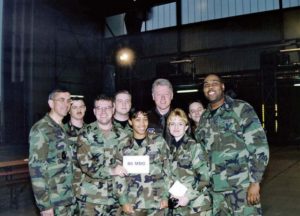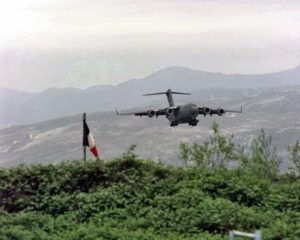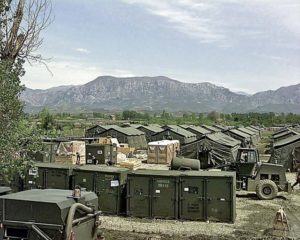by Shireen Bedi
Air Force Surgeon General Public Affairs

This year marks the 20th anniversary of the Air Force Medical Service’s involvement in Operation Allied Force and the humanitarian support in Operation Shining Hope, and the first deployment of the Air Force’s Expeditionary Medical Support System, or EMEDS.
EMEDS, a modular field hospital system, remains one of the Air Force’s core deployable medical capabilities, seeing action in numerous contingencies and humanitarian relief efforts over the past 20 years.
In the mid 1990s the AFMS underwent a realignment, based on lessons learned in the Persian Gulf War. Shining Hope was the first large-scale deployment after that process, and the AFMS used its new expeditionary medical assets for the first time.
These medical assets marked a significant shift in the AFMS’s capabilities, prioritizing flexibility, scalability and rapid deployability, all modernized to meet the needs of commanders.
The contingency and its supporting humanitarian efforts were different from previous conflicts. Operation Allied Force was primarily an air campaign, with few ground forces. Because of this, any medical support required a small footprint. The AFMS’s new expeditionary medical capabilities played a pivotal role in meeting this new requirement.

“The medical footprint had to be small,” said Brig. Gen. Mark Koeniger, who served as the Air Transportable Clinic Chief during Operation Shining Hope and now serves as the Air Force Medical Readiness Agency commander. “When we landed in Tirana, Albania, the base wasn’t built out yet; there wasn’t a lot of extra property that you could take over and expand into. We had to be small and efficient.”
Between April and June of 1999, more than 300 Air Force medics deployed to the Balkans, across 23 locations. Operations were also supported by in-place medical care from the 31st Medical Group at Aviano Air Base, Italy. Most operations were conducted by deployed squadron medical element units and aeromedical evacuation units. Squadron medical element units provided flight medicine and primary care to deployed forces and consisted of a flight surgeon and two aeromedical technicians.
Most significantly, EMEDS deployed for the first time during Shining Hope, despite the AFMS not finalizing them until September 1999. During this time, the Air Force deployed two 10-bed Air Transportable Hospitals, part of the EMEDS. One was in Taszar, Hungary, to help Army and Navy medics, and one in Balikesir, Turkey.
The 86th Air Expeditionary Medical Squadron from Ramstein Air Base, Germany, also deployed to Tirana, Albania, on April 7, 1999, in support of Operation Shining Hope. They provided lift-efficient surgical support, outpatient medical care and medical evacuation out of an Air Transportable Clinic.
“I had never set up a medical base before,” said Koeniger. “Usually you arrive at a base and you have some facilities and you step into something that is already there. This time, we literally arrived to nothing.
“Equipped with a small team of one flight surgeon, an internist, a medical technician, a public health team and bioenvironmental engineers, we were able to set up standard, austere environmental medical support for Operation Shining Hope.”
As Koeniger explained, setting up the EMEDS tent involved extensive planning and consideration to ensure it successfully supported the mission. The medics and civil engineers had to consider location of the medical tent and consider potential public health concerns.
“There was as stream flowing next to the tent, and we had to check with the public health team to make sure there would be no issues with mosquitos or other insects that could harm patients,” said Koeniger. “We ended up setting up the tents on slightly higher ground. This proved to be beneficial since the rain caused significant flooding issues to most of the base. The medical tent was not affected.”

Air Force medical efforts during Operation Allied Force and Operation Shining Hope were praised by commanders and leadership on how modular and scalable their support was, further proving the success of the new deployed medical support from the AFMS.
The most notable praise came from former Secretary of Defense William Cohen in a report to Congress following these operations.
“Many of the service medical units currently in use are sized for a major theater war and are cumbersome when used for smaller scale contingency deployments. The Air Force’s Expeditionary Medical Support and Air Force Theater Hospital are modularized, able to rapidly deploy to provide forward stabilization across the full spectrum of military and humanitarian operations.”
This modular medical footprint was not only vital in the success of these Balkan operations, but will continue to be a vital feature as the AFMS continuously innovates to meet the evolving readiness requirements moving forward.
“Having this scalable footprint was important back then and continues to be a key component of our medical capabilities,” said Koeniger. “During these operations, you needed the ability to rapidly deploy to provide the necessary medical support. And moving forward, this is the right way to go — to be lighter, leaner and even more responsive to shifting operational requirements.”


